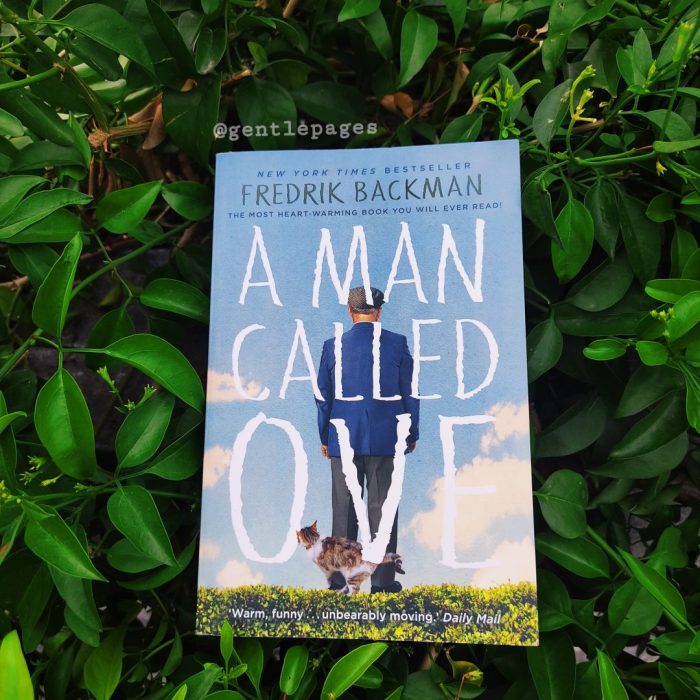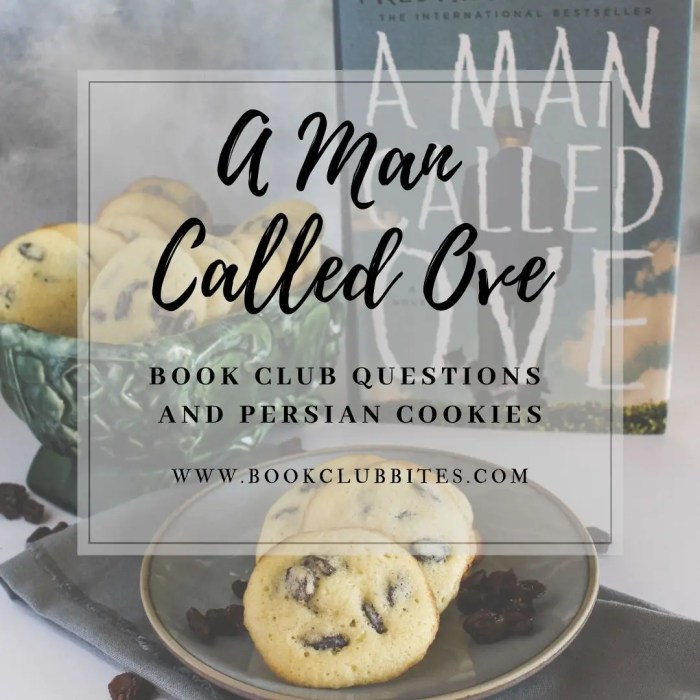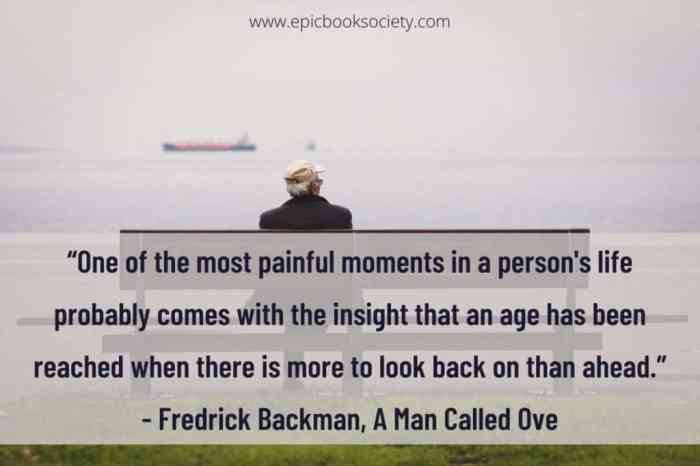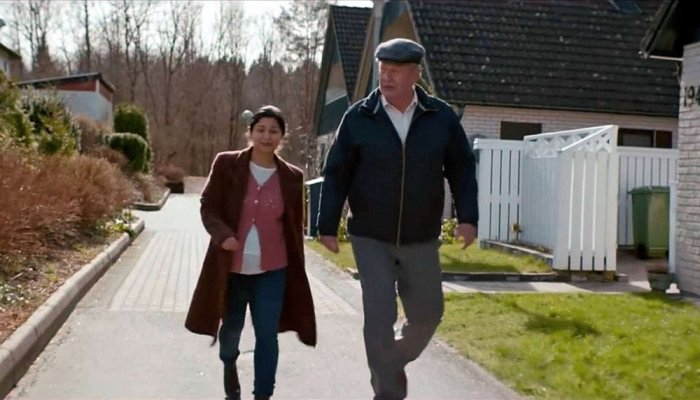Discussion questions a man called ove – Embark on a thought-provoking journey with “A Man Called Ove,” a novel that delves into the complexities of isolation, grief, and societal critique. Ove, a grumpy and isolated individual, undergoes a transformative journey that challenges societal norms and expectations.
This discussion guide provides insightful questions that explore Ove’s character development, strained relationships, and the profound themes of loss, grief, and social commentary woven throughout the narrative.
Ove’s Character and Development
Initially portrayed as a grumpy and isolated individual, Ove undergoes a gradual transformation throughout the novel. His initial standoffishness stems from a combination of personal loss, social isolation, and a rigid adherence to routine.
Ove’s transformation is catalyzed by several factors, including his unexpected friendship with Parvaneh, the gradual acceptance of his new neighbors, and the realization of his own mortality. Through these experiences, Ove begins to question his long-held beliefs and behaviors, leading to a gradual softening of his character and a newfound appreciation for human connection.
Ove’s Relationship with Parvaneh
Parvaneh’s unwavering kindness and determination to befriend Ove challenge his preconceived notions about immigrants and disrupt his solitary existence. Her persistent efforts gradually break down Ove’s defenses, leading him to question his own prejudices and embrace a more compassionate perspective.
Relationships and Isolation

Ove’s relationships with his neighbors and the community are strained, characterized by isolation and a lack of connection. He often engages in confrontations and displays a hostile attitude, leading to his social isolation.
Significance of Parvaneh and her Family, Discussion questions a man called ove
Parvaneh and her family play a transformative role in Ove’s life. Their kindness, understanding, and persistence gradually break down his emotional barriers. Through their interactions, Ove experiences a sense of belonging and purpose that he had long been missing.
Themes of Isolation and Loneliness
The novel explores the themes of isolation and loneliness through Ove’s character. His past experiences and present circumstances have left him feeling disconnected and alone. However, the relationships he forms with Parvaneh and her family offer him a glimmer of hope and the possibility of overcoming his isolation.
Themes of Loss and Grief

Loss and grief are central themes in A Man Called Ove. Ove’s past experiences with loss shape his character and drive his actions throughout the novel. He has lost his wife, his parents, and his friends, and these losses have left him isolated and embittered.
Ove copes with grief in different ways. Initially, he withdraws from the world and refuses to engage with others. He is angry and resentful, and he takes out his frustrations on those around him. However, as the novel progresses, Ove begins to open up to others and to find new meaning in life.
Memory and the Past
Memory and the past play a significant role in the novel. Ove is haunted by the memories of his loved ones, and he often retreats into the past to escape the pain of the present. However, memory can also be a source of comfort and strength.
It can help Ove to connect with his loved ones and to find meaning in his life.
Social Commentary and Critique: Discussion Questions A Man Called Ove

Fredrik Backman’s A Man Called Oveoffers a poignant critique of modern society and its values, exploring the themes of community, belonging, and the importance of human connection.
The novel portrays a society that is increasingly isolated and disconnected, where individuals are consumed by their own self-interests and have lost sight of the importance of community. Ove, the protagonist, is a prime example of this isolation. He is a grumpy and solitary old man who has withdrawn from society after the death of his wife.
However, as the novel progresses, Ove begins to realize the importance of human connection and the value of community.
Community and Belonging
A Man Called Oveemphasizes the importance of community and belonging. Ove’s journey from isolation to acceptance is a testament to the power of human connection. Through his interactions with his neighbors, Ove learns to open up and trust others. He discovers that he is not alone and that there are people who care about him.
The novel also explores the role of community in providing support and assistance to its members. Ove’s neighbors come together to help him with various tasks, such as shoveling his driveway and fixing his car. This sense of community is essential for Ove’s well-being and helps him to feel connected to others.
Challenging Societal Norms
A Man Called Ovealso challenges societal norms and expectations. Ove is a character who does not conform to society’s expectations of how an elderly man should behave. He is grumpy, opinionated, and often rude. However, Ove’s non-conformity is ultimately what makes him a relatable and lovable character.
Through Ove, Backman challenges the idea that elderly people should be docile and passive. Ove is a strong and independent individual who refuses to give up on his beliefs. He is a reminder that age does not define a person and that it is never too late to change.
Symbolism and Motifs

In “A Man Called Ove,” symbolism and recurring motifs play a pivotal role in enhancing the novel’s themes and character development.
The Saab
Ove’s Saab symbolizes his rigid adherence to routine and control. It represents his past, his connection to his deceased wife, and his resistance to change. Ove’s meticulous care for the Saab reflects his desire for order and predictability.
The Cat
The cat initially symbolizes Ove’s isolation and reluctance to connect with others. However, as Ove begins to care for the cat, it becomes a symbol of his gradual transformation and growing capacity for compassion.
The Bicycle
The bicycle symbolizes freedom and mobility. Ove’s inability to ride the bicycle reflects his physical limitations and his fear of change. However, the bicycle also represents Ove’s potential for growth and his desire to overcome his fears.
Routines, Order, and Control
Recurring motifs of routines, order, and control highlight Ove’s rigid personality and his need for predictability. Ove’s adherence to these motifs reflects his coping mechanism for dealing with the loss of his wife and the challenges of old age.
Frequently Asked Questions
What is the significance of the Saab in the novel?
The Saab serves as a symbol of Ove’s past, his connection to his deceased wife, and his struggle to let go of the familiar.
How does Ove’s relationship with Parvaneh and her family challenge his isolation?
Parvaneh’s kindness, resilience, and unwavering support gradually break down Ove’s barriers, showing him the value of human connection and community.
What does the novel reveal about the challenges of aging and the importance of intergenerational relationships?
“A Man Called Ove” highlights the loneliness and isolation often faced by the elderly, emphasizing the crucial role of younger generations in fostering meaningful connections and bridging generational gaps.